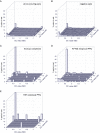Quantitative Tagless Copurification: A Method to Validate and Identify Protein-Protein Interactions
- PMID: 27099342
- PMCID: PMC5083090
- DOI: 10.1074/mcp.M115.057117
Quantitative Tagless Copurification: A Method to Validate and Identify Protein-Protein Interactions
Abstract
Identifying protein-protein interactions (PPIs) at an acceptable false discovery rate (FDR) is challenging. Previously we identified several hundred PPIs from affinity purification - mass spectrometry (AP-MS) data for the bacteria Escherichia coli and Desulfovibrio vulgaris These two interactomes have lower FDRs than any of the nine interactomes proposed previously for bacteria and are more enriched in PPIs validated by other data than the nine earlier interactomes. To more thoroughly determine the accuracy of ours or other interactomes and to discover further PPIs de novo, here we present a quantitative tagless method that employs iTRAQ MS to measure the copurification of endogenous proteins through orthogonal chromatography steps. 5273 fractions from a four-step fractionation of a D. vulgaris protein extract were assayed, resulting in the detection of 1242 proteins. Protein partners from our D. vulgaris and E. coli AP-MS interactomes copurify as frequently as pairs belonging to three benchmark data sets of well-characterized PPIs. In contrast, the protein pairs from the nine other bacterial interactomes copurify two- to 20-fold less often. We also identify 200 high confidence D. vulgaris PPIs based on tagless copurification and colocalization in the genome. These PPIs are as strongly validated by other data as our AP-MS interactomes and overlap with our AP-MS interactome for D.vulgaris within 3% of expectation, once FDRs and false negative rates are taken into account. Finally, we reanalyzed data from two quantitative tagless screens of human cell extracts. We estimate that the novel PPIs reported in these studies have an FDR of at least 85% and find that less than 7% of the novel PPIs identified in each screen overlap. Our results establish that a quantitative tagless method can be used to validate and identify PPIs, but that such data must be analyzed carefully to minimize the FDR.
© 2016 by The American Society for Biochemistry and Molecular Biology, Inc.
Figures







Similar articles
-
Bacterial Interactomes: Interacting Protein Partners Share Similar Function and Are Validated in Independent Assays More Frequently Than Previously Reported.Mol Cell Proteomics. 2016 May;15(5):1539-55. doi: 10.1074/mcp.M115.054692. Epub 2016 Feb 12. Mol Cell Proteomics. 2016. PMID: 26873250 Free PMC article.
-
Mapping Protein-Protein Interactions Using Affinity Purification and Mass Spectrometry.Methods Mol Biol. 2017;1610:231-249. doi: 10.1007/978-1-4939-7003-2_15. Methods Mol Biol. 2017. PMID: 28439867
-
In vivo cross-linking-based affinity purification and mass spectrometry for targeting intracellular protein-protein interactions.Anal Chim Acta. 2023 Jul 18;1265:341273. doi: 10.1016/j.aca.2023.341273. Epub 2023 May 4. Anal Chim Acta. 2023. PMID: 37230567
-
Recent progress in mass spectrometry-based strategies for elucidating protein-protein interactions.Cell Mol Life Sci. 2021 Jul;78(13):5325-5339. doi: 10.1007/s00018-021-03856-0. Epub 2021 May 27. Cell Mol Life Sci. 2021. PMID: 34046695 Free PMC article. Review.
-
Interactome evolution: insights from genome-wide analyses of protein-protein interactions.Curr Opin Struct Biol. 2018 Jun;50:42-48. doi: 10.1016/j.sbi.2017.10.012. Epub 2017 Nov 5. Curr Opin Struct Biol. 2018. PMID: 29112911 Review.
Cited by
-
Gain- and Loss-of-Function Screens Coupled to Next-Generation Sequencing for Antibiotic Mode of Action and Resistance Studies in Streptococcus pneumoniae.Antimicrob Agents Chemother. 2019 Apr 25;63(5):e02381-18. doi: 10.1128/AAC.02381-18. Print 2019 May. Antimicrob Agents Chemother. 2019. PMID: 30783004 Free PMC article.
-
Large-scale genetic characterization of the model sulfate-reducing bacterium, Desulfovibrio vulgaris Hildenborough.Front Microbiol. 2023 Mar 31;14:1095191. doi: 10.3389/fmicb.2023.1095191. eCollection 2023. Front Microbiol. 2023. PMID: 37065130 Free PMC article.
-
The World of Stable Ribonucleoproteins and Its Mapping With Grad-Seq and Related Approaches.Front Mol Biosci. 2021 Apr 7;8:661448. doi: 10.3389/fmolb.2021.661448. eCollection 2021. Front Mol Biosci. 2021. PMID: 33898526 Free PMC article. Review.
-
Next-generation Interactomics: Considerations for the Use of Co-elution to Measure Protein Interaction Networks.Mol Cell Proteomics. 2020 Jan;19(1):1-10. doi: 10.1074/mcp.R119.001803. Epub 2019 Dec 2. Mol Cell Proteomics. 2020. PMID: 31792070 Free PMC article. Review.
-
Drosophila SUMM4 complex couples insulator function and DNA replication control.Elife. 2022 Dec 2;11:e81828. doi: 10.7554/eLife.81828. Elife. 2022. PMID: 36458689 Free PMC article.
References
-
- Alberts B., Johnson A., Lewis J., Raff M., Roberts K., and Walter P. (2007) Molecular Biol. Cell, 5 edition ed., Garland Science, New York.
-
- Kristensen A. R., and Foster L. J. (2013) High throughput strategies for probing the different organizational levels of protein interaction networks. Mol. bioSystems 9, 2201–2212 - PubMed
-
- von Mering C., Krause R., Snel B., Cornell M., Oliver S. G., Fields S., and Bork P. (2002) Comparative assessment of large-scale data sets of protein-protein interactions. Nature 417, 399–403 - PubMed
-
- Edwards A. M., Kus B., Jansen R., Greenbaum D., Greenblatt J., and Gerstein M. (2002) Bridging structural biology and genomics: assessing protein interaction data with known complexes. Trends Gen. 18, 529–536 - PubMed
MeSH terms
Substances
Grants and funding
LinkOut - more resources
Full Text Sources
Other Literature Sources
Molecular Biology Databases

